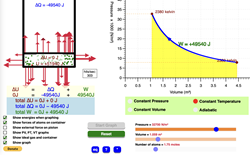Chemistry
 Making An Ion
Making An Ion
You know that great feeling after eating a big meal and becoming
full? Or the
positive feeling after losing a little extra
negative weight? Atoms are like that too! In this interactive, you'll see how atoms with a nearly full outer shell can take on a couple electrons to complete themselves, or shed some electrons if they have a nearly empty shell, and how the charges change.

Now available with a Concept Checker.
 Electronegativity
Electronegativity
Two approaching atoms will interact in such a way as to form a bond. But not all bonds are created equal. So what distinguishes one bond fron another bond? And is there a model for predicting what type of bond will form? Explore these questions with our Electronegativity simulation.

Now available with a Concept Checker.
 Dissolving a Salt Crystal
Dissolving a Salt Crystal
Your Sodium Chloride crystal landed in water and dissolved, leaving you feeling salty. Where did it go and how? Let's find out in this simulation showing how water dissolves molecules and how you can dehydrate to get them back.
 Dissolving a Sugar Crystal
Dissolving a Sugar Crystal
You wanted to make your tea hot sticky sweet, so you poured some sugar on it. After a couple seconds, the sugar disappears. Sweet! But you may ask, what happened to it? Let's find out in this simulation showing how water dissolves a sugar crystal and how you can dehydrate to get it back.
 Average Atomic Mass
Average Atomic Mass
Old Rickety is an old relic of a mass spectrometer that still provides reliable data on the percent adundance and atomic mass of the isotopes of an element. Get together with Old Rickety and see if you can use the data to calculate the average atomic mass of a sample of an element.

Available with Task Tracker compatibility.
Learn more.
 Limiting Reactants
Limiting Reactants
Load up a reactor with reactants and run a trial. Observe results. Make changes. Observe the effects of the changes. You can do a lot with this simulation but one thing you can't do is to clean up or break any glassware. The simulation allows you to investigate how the ratio of available moles of reactants results in leftover reactants and affects the amount of product produced. Eight different reactions can be studied.

Now available with a Concept Checker.
 Phase Change Lab
Phase Change Lab
They say a pot watched never boils. Well, this one will, and you'll definitely want to watch it! The Phase Change Lab demonstrates the phase changes of water in a heated pot, starting from solid ice and eventually making it's way to the gaseous state, all while showing intermolecular forces and the time/temperature for you to graph out later.

Now available with a Concept Checker.
 The Ammonia Factory
The Ammonia Factory
You've been assigned the job of running the production line at the ammonia factory. Your goal is to identify the design parameters that will increase the daily yield of ammonia. You can modify reactor temperatures and pressures and the nitrogen and hydrogen flow rates and observe the effect upon percent yield, daily ammonia production, your carbon footprint, and safety risks. Get started quick because your job ends in 180 days. Good luck!
 Ideal Gas Behavior
Ideal Gas Behavior
Need a gas-filled cylinder equipped with a piston? How about a thermometer, a pressure gauge, and a means of determining the volume and the number of moles of gas inside the cylinder? No worries because we have you covered with our Ideal Gas Behavior simulation. Set up your initial state of the gas, identify your constraints (e.g., constant T, constant V, etc.), modify a variable and observe the effect on other variables.